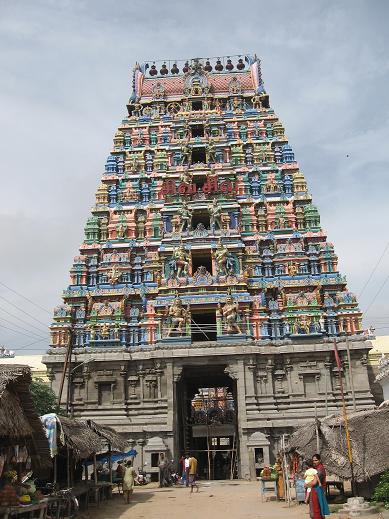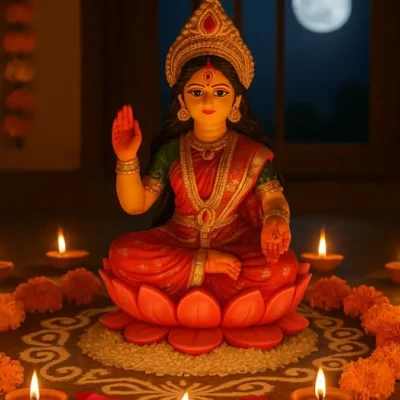Virinchipuram Margabandheeshwarar Temple, Vellore

Address
Virinchipuram Margabandheeshwarar Temple, Virinchipuram, Vellore district- 632104.
Diety
Margabandheeshwarar/ Vazhi Thunai Nathar. Amman: Maragathambigai / Maragathavalli.
Introduction
Margabandheeshwarar Temple is dedicated to Lord Shiva located at Virinchipuram Village in Vellore District of Tamilnadu. This beautiful temple is 1300 years old and is known for its impressive Rajagopurams and sculptures. The Temple is considered as Thevara Vaippu Sthalam as Devaram hymns had a mention about this Temple. The temple is famous for its compound wall (Madhilazhagu) which is exquisite in having minute stone carvings all around. Presiding Deity is called as Margabandheeshwarar / Vazhi Thunai Nathar. Mother is called as Maragathambigai / Maragathavalli. The Temple is believed to be sung by many namely, Appar, Sambandhar, Arunagiri Nadhar. Arunachala Puranam, Siva Rahasyam, Brahmanda Puranam, Kanch Puranam and many other Holy books have described this temple in their Puranas. This Temple is one of the oldest and the biggest temple of Vellore district.
Puranic Significance
The main shrine of the temple is said to have been built by Rajaraja Chola, Samburvarayar, and the viceroy of Kulothunga Chola. Nandhi Vikrama Pallava, Rajendra Chola, Parantaka Chola and Vijayanagara kings – Narayana Sambuvarayar, Achutharayar, Devaraya have all contributed significantly to this temple. Lord Brahma was born as Shivasarma here in a priest family. When Shivasarma father died at his early days, Shivasarma was to undertake the pooja responsibilities as a small boy. Shivasarma’s relatives had planned to take away the priest’s rights and land from them and so they warned that his rights and land will be taken away, if he does not perform the pooja when his turn comes up. Shivasarma’s mother prayed to Margapandeswarar and he appeared in her dream. It was the last Saturday night of the Karthigai month. The next morning, Shivasarma took bath in the Brahma Theertham and Lord Shiva came as an elderly person & conducted the Upanayanam, Brahmopadhesam and Shiva Dhiksha to Shivasarma and disappeared as Mahalingam in the temple tank bund. The small boy was then paraded on an elephant with the holy water pot and the temple door opened automatically to everyone’s surprise. As if he was very experienced in the pooja procedures, he conducted the pooja activities to Swarna Ganapathy and while attempting to do the Abhishekam for the Margabandheeshwarar, as a small boy, he was unable to reach the head of the lingam. He then submitted his inability to Lord Shiva. In another legend, once Brahma and Vishnu got into an ego battle and they set out to reach the head and foot of Lord Shiva but both failed. Brahma lied to Shiva that he had seen the head with Thazhampoo as a false witness but here Lord Brahma accepted his inability to reach the head of Lord Shiva and offered his failure to the Lord himself. Lord Shiva, then bowed his head to accept the Abhishekam and Brahma got his curse cleared off and attained salvation. So, the Margabandheeshwarar lingam can be seen in a slightly tilted position here.
Beliefs
The childless couples take dip in all the three Theerthams of the temple, stay overnight with the wet cloth to receive the Lord in their dream and get the boon of a child. Since Lord Shiva of this temple protected the pepper merchant Dhanabalan, the business people can have this Lord Shiva as the protector for their business. Since Lord Shiva had conducted the Upanayanam and Dhiksha to Lord Brahma here, this is a holy place to have Upanayanams, to get Dhiksha and to start education. The last Sunday of the Karthika masa or month is considered very auspicious since on that day, Lord Shiva appeared as an elderly person and conducted Upanayanam for Lord Brahma as Shivasarma. Taking a dip at the Simha Theertham here will remove the evil effects of bad omens. By worshipping here, people get their marriage obstacles removed and get their marriages conducted here. Devotees also throng the temple for relief from the effects of witchcrafts occupying the family or the individual. Devotees perform abishek to Lord with gingelly oil, turmeric, corn flours, milk, curd, fruits, sugarcane juice, honey. Panchamritham – a mixture of items -, sandal, rose water and sacred ashes. They also perform abishekam to Mother Maragathambigai with turmeric powder and offer Saris and dhoti to the Lord. They also arrange feeding the devotees and abishek with conches in the month of Karthikai covering November-December. The wealthy donate liberally for the maintenance and renovation of the temple.
Special Features
This is the birth place of Sri Appayya Dikshitar (1520-1593), the greatest interpreter of Advaita Siddhantha after Adhi Sankara. His Margabandhu stotram on this Margabandheeshwarar is for the protection of people while on journey. By reciting this one can have Lord Shiva with them as Margabandhu (protector during journey) along their journey. Gowri Devi, Lord Brahma, Lord Vishnu and Lord Sriharan had worshipped here. This temple is also known as ‘Bhaskara Kshetram’ because the Sun God is said to worship the Linga when its rays fall on it in the month of Panguni. The name of the place as Virinchipuram came from the legend that the temple was worshipped by Brahma, i.e., Virinchi. The Theertham of this temple is said to be created by Gowri Devi and so, this place is also known as Gowripuram. Vishnupuram and Margabandheeswaram are also the other names of the place. This beautiful temple is 1300 years old and is known for its impressive Rajagopurams and sculptures. ‘Virinchipuram Madhil Azhahu’ is a popular saying. There is miniature Rajagopurams on the temple wall itself on two sides. If a small Rajagopuram itself can be built on the temple wall, the grandeur of the temple wall can be imagined. Also, this has a sacred significance that the Siddhars, Sages and Celestial Gods are believed to come here for worship during the nights through these exclusive entrances for them where the normal humans cannot enter. The Temple is having 7-tiered east facing 110 feet high Rajagopuram. There are 5 praharams in the temple. The entrance door is almost 18 feet high made of wood. The temple walls, the Rajagopuram and the big Mada streets all add up to a beautiful view and set the tone for what is in store inside. The first mandapam after entering the houses the Dwajasthambam, Bali peetam and Nandhi. As a rare sight, there are two Dwajasthambams in this temple, one for the main shrine and another, exclusive for the Amman shrine as well.
Festivals
10-day Brahmmotsavam with flag hoisting and Theerthavari in in Panguni (March-April) when the presiding deity is taken on a procession in different vahans, last Sunday in the month of Karthikai (November-December) when over 2000 devotees will have a dip in Simha tank, Adipooram in JulyAugust. Shivarathri in February-March, Navarathri in September-October, are the festivals grandly celebrated in the temple when devotee crowd would be huge. Other festival days include full moon days, monthly Pradoshams (13th day either from new moon or full moon days), Amavasya the new moon day, Kruthika star days each month, Sashti in October-November, Visakam in May-June, Thaipoosam in January-February, Sankatahara Chaturthi each month (4th day either from new moon or full moon days), Karthikai deepam in November-December. Special pujas are performed on Tamil and English new year days, Deepavali and Pongal days
Century/Period/Age
1000 Years old
Managed By
HRCE
Nearest Bus Station
Seduvalai
Nearest Railway Station
Katpadi Station
Nearest Airport
Chennai









